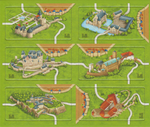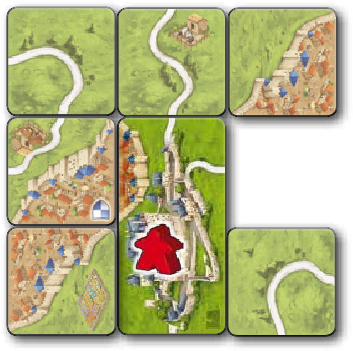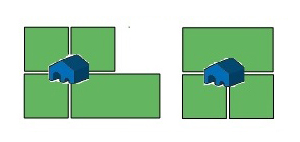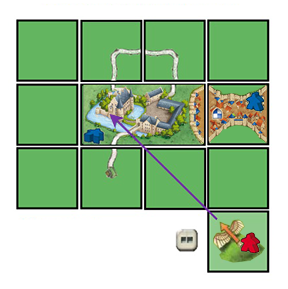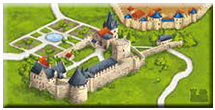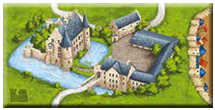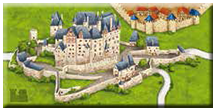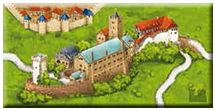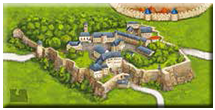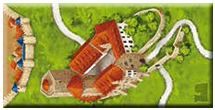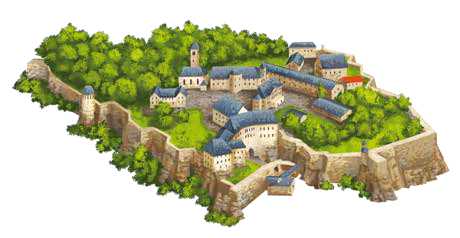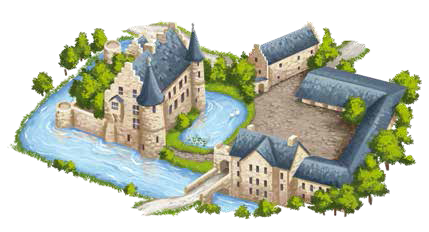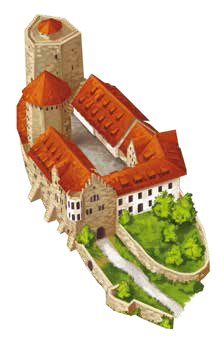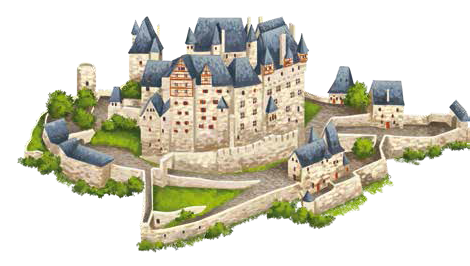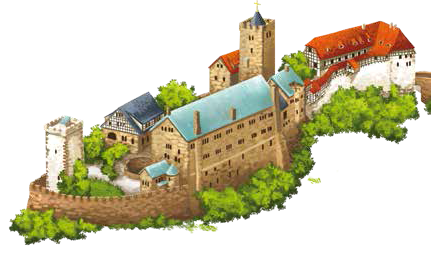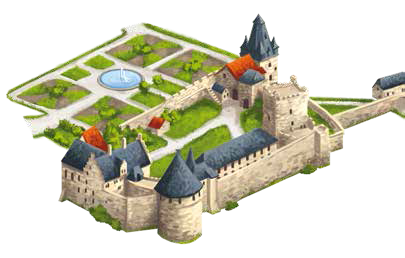Difference between revisions of "Castles in Germany/fr"
(Created page with "'''Château d'Eltz''' (Rhénanie-Palatinat)") |
(Created page with "500px|Château de la Wartburg (Thuringe)") |
||
| Line 194: | Line 194: | ||
----- | ----- | ||
[[File:German_Castles_C2_Castle_Image_05.png|500px|Wartburg | [[File:German_Castles_C2_Castle_Image_05.png|500px|Château de la Wartburg (Thuringe)]] | ||
'''Wartburg Castle''' (Thuringia) | '''Wartburg Castle''' (Thuringia) | ||
Revision as of 19:31, 30 October 2020
Informations générales et commentaires
Châteaux d’Allemagne (Burgen in Deutschland) a été éditée pour la nouvelle édition par Hans im Glück en Template:Year fr. Cette mini extension a été éditée pour la 1ère édition en Template:Year fr.
Cette mini extension ajoute 6 célèbres châteaux allemands à vos parties de Carcassonne et transforme chaque joueur en seigneur.
Cette mini extension a été conçue pour le jeu de base de Carcassonne et suit donc les règles normales du jeu. Vous pouvez utiliser "Châteaux d'Allemagne" avec toutes les autres extension du jeu, mais il n’existe aucune règle officielle pour expliquer les différentes interactions possibles.
Matériel
- 6 doubles tuiles Terrain représentant de célèbres châteaux allemands
Règles
Mise en place
Chaque joueur choisit un château de son choix. Lorsque vous jouez à deux ou trois joueurs, vous pouvez prendre 2 châteaux chacun. Vous pouvez également mélanger les tuiles de château et les distribuer. Ensuite, vous placez vos tuiles de château devant vous.
Déroulement du jeu
1. Placement d'une tuile
Au lieu de prendre une tuile Terrain de la pile de pioche, les joueurs peuvent placer un de leurs châteaux. Notez qu'une tuile Château ne doit pas toucher une autre tuile Château, ni directement ni avec les bords (en diagonale). Toutes les autres règles de placement restent les mêmes que dans le jeu de base.
2. Pose d'un meeple
Après avoir placé leur tuile Château, les joueurs sont autorisés à poser un meeple. Ils peuvent poser le meeple sur une route, une ville ou un pré ou en tant que seigneur dans le château.
3. Évaluation des zones
Évaluation d'un château complété
Un château peut être complété et évalué de la même manière que les abbayes. Dès que le château est entouré d'autres tuiles Terrain, le seigneur à sa tête obtient 12 points et ramène son meeple dans sa réserve.
À la fin de la partie, toutes les tuiles Terrain entourant un château incomplet marquent un point. La tuile Château elle-même compte pour 2 points.
Évaluation des routes et des villes autour d'un château [1] [2]
Si une route ou une ville qui se termine sur la tuile Château est complétée, les joueurs obtiennent des points bonus. Chaque joueur qui obtient des points reçoit 3 points bonus pour chaque château concerné [3] [4]. Que le château soit occupé ou non ne fait aucune différence.
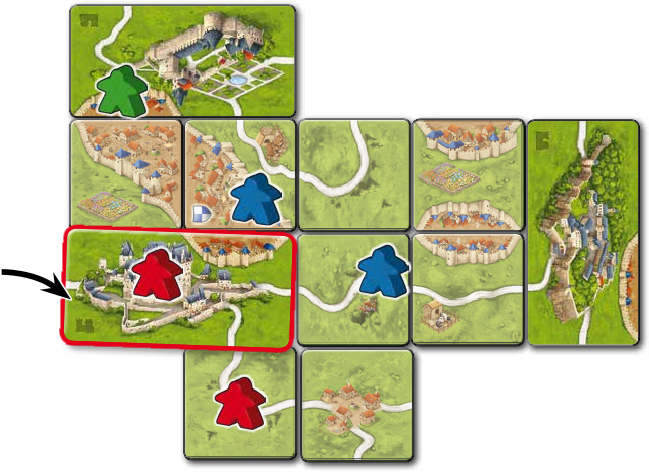
- Rouge place le château dans le coin inférieur gauche et y pose un meeple. Rouge complète 2 routes et 1 ville en faisant cela.
- Vert etBleu obtiennent 16 points pour leur ville. (10 points pour la ville et 2 x 3 points pour les châteaux)
- Rouge obtient 6 points pour sa route (3 points pour la route et 3 points pour le château)
- Bleu obtient 10 points pour sa route (4 points pour la route et 2 x 3 points pour les châteaux)
À la fin de la partie, il n'y a pas de points bonus pour les villes ou les routes.
Autres extensions
>> Considérations d’ordre général
- Cette section contient des éclaircissements concernant l'interaction des châteaux d'Allemagne avec d'autres expansions (depuis octobre 2015)
>> Ext. 2 - Auberges et Cathédrales - Points bonus
- L'évaluation se fait d'abord pour les routes avec une auberge ou une ville avec une cathédrale, puis le bonus +3 de tout château d'Allemagne est ajouté.
>> Ext.3 - Princesse et Dragon – Déplacement du dragon
- German castles do not protect followers from the dragon. The German castle is on one tile, so it has less functions than a castle (from Bridges, Castles and Bazaars) that sits between 2 tiles. The function or the mechanics of the German castle is more like those of a monastery.
- The German castle tile is one single tile - so the dragon needs only one of his 6 moves for this tile and then continues on its way.
>> Ext. 4 - La Tour – Portée de la Tour
- German castles count as one tile for the tower range.
>> Ext. 5 - Maires et Monastères – Partie 1 : Mouvement du charriot
- The wagon can be placed on a German castle.
- The wagon can be driven to a German castle after completing a road that is connected to the German castle - as long as the German castle is not finished and no other follower owns it.
>> Ext. 5 - Maires et Monastères – Partie 2 : Pose d’une grange
- The general rule states that the base for the barn has to be stable - that means that the corner of all four tiles have to touch each other and all tiles must have field in the corner for the placement of the barn.
- A German castle tile can therefore occupy one or two of the corners under the barn.
>> Ext. 6 - Ponts, Forteresses et Bazars - Les Forteresses
- You can build a small city including the semicircular city segment on a German castle tile. If this small city is converted into a castle, neither the small city at that point nor the castle, if scored, will receive bonus points for the German castle.
>> Mini n°1 - Les Ornithoptères - Distance et pose d'un ornithoptère
- The German castle counts as 1 tile. If the flier lands on this tile then the flier has the choice of 3 roads, 1 city or the German Castle (the function or the mechanics of the German Castle is more like those of a monastery.) The flier can only land on one of these features if it is not yet finished.
- If the flight of the flier is diagonal, all steps must be in a straight line in the direction the arrow shows from the flying machine tile. The angle cannot change but it would if it had entered via one corner of the German castle tile, and exited via the opposite corner. If the flier lands on the German castle tile then the flier has the choice of 3 roads, 1 city or the German Castle. The flier can only land on one of these features if it is not yet finished.
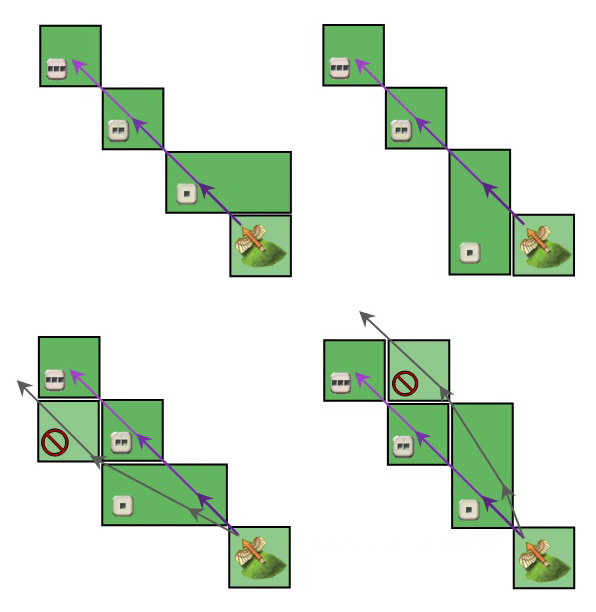 Example F2: These examples show a diagonal flier trajectory involving German castle tiles. The violet arrow indicates the correct trajectory following the flying machine direction. The grey arrow shows an invalid diagonal trajectory as it deviates from the trajectory indicated by the flying machine.
Example F2: These examples show a diagonal flier trajectory involving German castle tiles. The violet arrow indicates the correct trajectory following the flying machine direction. The grey arrow shows an invalid diagonal trajectory as it deviates from the trajectory indicated by the flying machine.
>> La Peste - Propagation de la peste
- A German castle counts as 1 tile for the plague tokens.
>> Abbayes d'Allemagne et Monuments Japonais / Abbayes d'Allemagne / de Hollande et de Belgique - Évaluation de l'abbé
- There is no explicit clarification on how German castles affect the scoring of the abbot on a Monastery. It seems reasonable to apply the principles provided for The Tower above.
Ensemble des tuiles
Total de tuiles: 6
Les châteaux en détail
Forteresse de Königstein (Saxe)
This castle is one of Europe's biggest hilltop fortresses. It is situated in Saxon Switzerland in the Elbe Sandstone Mountains near Dresden. The fortress was built on top of a rock plateau 240 meters above the river Elbe. Over a period of more than 750 years, this place became an impressive ensemble of buildings of the late gothic period, the renaissance, the baroque and the 19th century.
http://www.festung-koenigstein.de
Château de Konradsheim (Rhénanie du Nord/Westphalie)
This water castle is situated between Cologne and Bonn and is one of the few castles of the late Middle Ages in the Rhineland still preserved. The knight Arnold von Buschfeld is said to be the builder of this castle. First mentioned in a document in 1337, the castle is nowadays private property and can be rented for events.
http://www.burg-konradsheim.de
Château de Rieneck (Bavière)
This castle was built around 1150 near the town of Rieneck above the river Sinn in Lower Franconia in Bavaria. Today, the castle serves as a scouting facility and is owned by the German Christian Guide and Scout Association. Particularly well known – and the centrepiece of the castle – is the “Thick Tower“ built in the 12th century with his romantic wall chapel constructed completely enclosed by the keep's wall.
http://www.burg-rieneck.de
Château d'Eltz (Rhénanie-Palatinat)
It is considered the paragon of German castles. It is situated in the Eltz river valley near the Eifel. It was built in the beginning of the 12th century and has yet never been destroyed. Eltz castle has a history full of myths, luminaries and distinguished art.
http://www.burg-eltz.de
Wartburg Castle (Thuringia)
The Wartburg (Burg: german castle) is situated above the city of Eisenach in Thuringia. Built around 1067 under Louis the Springer ("the Jumper") the castle is – since 1999 – a UNESCO World heritage site. Between May 1521 and March 1522 Martin Luther, who had found shelter inside the Wartburg, translated the New Testament into German.
http://www.wartburg.de
Bentheim Castle (Lower Saxony)
This is a castle complex in the middle of the city of Bad Bentheim in Lower Saxony, which has been built in the Early Middle Ages. First mentioned in a document in the 11th century it is believed to be one of the largest and most beautiful castle complexes in north-western Germany. Nowadays, the castles museum can be visited year-round.
http://www.burg-bentheim.de
Footnotes
For Icons explanation and licensing please visit Icons page.
- ↑
 Question : Combien de points un château d'Allemagne rapporte-t-il lors de l'évaluation d'une abbaye ? Réponse : Comme les abbayes sont évaluées en fonction des espaces occupés par l'abbaye elle-même et ses espaces adjacents, une tuile Château d'Allemagne compte pour le nombre d'espaces qu'elle occupe : 1 ou 2 selon son emplacement par rapport à l'abbaye. (4/2020)
Question : Combien de points un château d'Allemagne rapporte-t-il lors de l'évaluation d'une abbaye ? Réponse : Comme les abbayes sont évaluées en fonction des espaces occupés par l'abbaye elle-même et ses espaces adjacents, une tuile Château d'Allemagne compte pour le nombre d'espaces qu'elle occupe : 1 ou 2 selon son emplacement par rapport à l'abbaye. (4/2020)
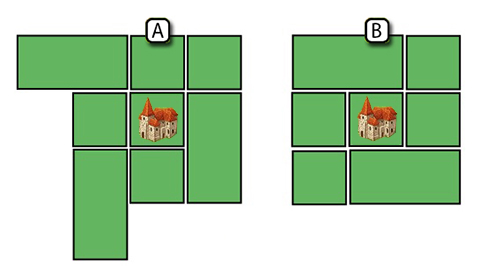 Exemples de l'évaluation d'une abbaye avec les châteaux d'Allemagne : Le joueur obtient 1 point pour la tuile de l'abbaye et 1 point par espace occupé autour de celle-ci, qu'il s'agisse d'une tuile carrée ou d'une partie d'une tuile double :
Exemples de l'évaluation d'une abbaye avec les châteaux d'Allemagne : Le joueur obtient 1 point pour la tuile de l'abbaye et 1 point par espace occupé autour de celle-ci, qu'il s'agisse d'une tuile carrée ou d'une partie d'une tuile double :- Exemple A : Cette abbaye complétée rapporte 9 points, avec 3 châteaux d'Allemagne dans son voisinage.
- Exemple B : Cette abbaye complétée rapporte 9 points, avec 2 châteaux d'Allemagne dans son voisinage.
- ↑
 Question : Un château d'Allemagne compte-t-il pour l'évaluation des prés ? Réponse : Non, cela ne compte pas pour l'évaluation du pré. Le château d'Allemagne se trouve sur une seule tuile, il a donc moins de fonctions qu'une forteresse qui se trouve construite entre deux tuiles. (10/2015)
Question : Un château d'Allemagne compte-t-il pour l'évaluation des prés ? Réponse : Non, cela ne compte pas pour l'évaluation du pré. Le château d'Allemagne se trouve sur une seule tuile, il a donc moins de fonctions qu'une forteresse qui se trouve construite entre deux tuiles. (10/2015)
- ↑
 Ainsi, une route dont chaque extrémité se trouve sur une tuile de château différente, obtiendrait une évaluation de 6 points bonus. Une route qui commence et se termine sur la même tuile de château ne recevra que 3 points bonus. (4/2015)
Ainsi, une route dont chaque extrémité se trouve sur une tuile de château différente, obtiendrait une évaluation de 6 points bonus. Une route qui commence et se termine sur la même tuile de château ne recevra que 3 points bonus. (4/2015)
- ↑
 Ces points bonus sont ajoutés à l'évaluation de la zone après les modifications des auberges ou des cathédrales. (10/2015)
Ces points bonus sont ajoutés à l'évaluation de la zone après les modifications des auberges ou des cathédrales. (10/2015)
- Editor Manual - Old numbered parameters - RulesPlacingTile
- Editor Manual - Old numbered parameters - RulesPlacingMeeple
- Editor Manual - Old numbered parameters - RulesScoring
- Editor Manual - Old numbered parameters - Tile
- Old template
- Old template - FootnoteIconPara en
- Second Edition
- Second Edition Minor Expansion
